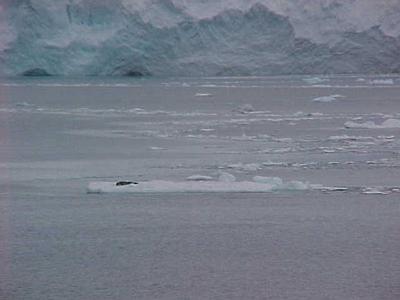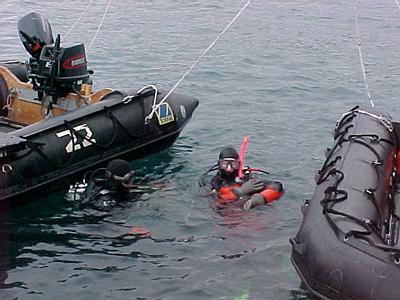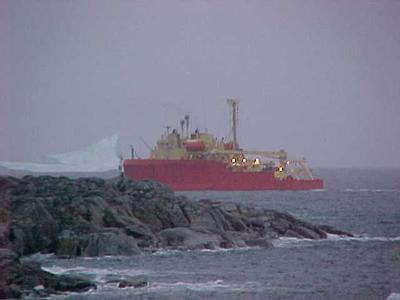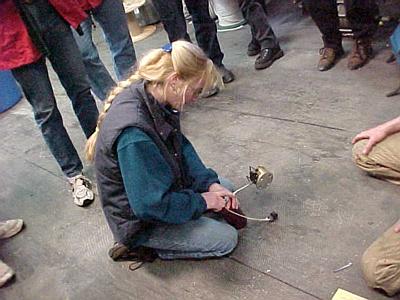9 March, 2000
First full day at Palmer Station; School and Diving
Question 19: What season of the year is it here on the Antarctic Peninsula?
What is this season like?
The L.M.Gould left this morning for its 10-day science cruise around the
mid-peninsula area for the groups of oceanographers on board. TEA Cathy
Roberts is with them.
Today we started off on the fast pace that will stay with us the whole time
we are on station. Since there were problems getting internet and email
access from the Gould while at sea, I will be posting the other journal
entries that have been piling up on my computer over the next several days.
Be sure to check out all the things we have done already! Now the science
starts more seriously.
Before we can get out into the field actively diving and collecting, we all
have to take some quick classes to orient us and keep us safe in the local
environment-- Boating 1, passengers, Islands and Boating 2, drivers. We also
need to do a check-out dive with all of our gear close to the station. We got
through Boating 1, Islands and the first dive today. If the weather
cooperates, Boating 2 will take place tomorrow morning.
Boating 1 is primarily concerned with making all people aware of the
procedures for going out in boats (sign-out board, take 2 radios, float coat
with beavertail attached, at least two drivers on board, etc.) and the dangers
inherent in the unpredictable weather in the area (risk of hypothermia,
problems caused by high winds, what to do in the event of several types of
emergencies). Since the weather can change very quickly and we can be 2 miles
away from the station, one of the possible emergency situations is getting
stuck away from the station in extremely bad weather. This is covered in the
Islands course.
The area around Palmer Station has many groups of small, rocky islands. The
majority of them have survival caches on them. A cache consists of three
30-gallon blue plastic barrels that contain food, water, tents, sleeping bags,
stoves and other useful gear. Each of the boats also has a bag of emergency
gear. There is enough tasty food for four people for over a week, then sea
rations (hard biscuits) for several weeks after that. We practiced setting up
the type of tent that is in the barrels and lighting the WhisperLite stoves
that are included. They told us that usually one group each season gets into
a situation where they have to use one of the caches. They haven' t had one
used yet this year, so keep your fingers crossed that we won't be the first!
After lunch, the weather was still too windy to go out for the Boating 2
course so we concentrated on getting our dive gear up and going. We split
into two teams so there would be three diving and three helping. We dove from
the station dock area on Hero Channel. It is more sheltered than most areas
but can get quite deep. My group got into the water before dinner and took a
20 minute tour of the close area. After I added more weight to my harness
(now that I have 40 lbs. I don't bob like a cork anymore), we went to a depth
of around 65 feet making a circular sweep around the boat mooring area looking
at the invertebrate and plant life. Besides the many limpets, macroalgae and
starfish, I saw a beautiful octopus. It was about 25 cm long and a mottled
orange color. It swam away from us as fast as possible. The limpets tend to
be pink/purple/white in color and the algae goes through reds, oranges and
greens. It is very colorful under water. While we were down, a small iceberg
floated up to our put-in/take-out site so we had to be careful exiting the
water!
The second group got into the water after dinner. It only sleeted on those
of us waiting on the shore a little bit. Fortunately, neither of our groups
saw the leopard seal that had been cruising by the boats earlier. Apparently
they like to chew on the ends of the Zodiac boat pontoons. When I was going
back up to my room after cleaning up the dive gear, I spotted one lounging on
an iceberg in the bay on the other side of the station.
Answer 18: The Hero was the original supply ship for Palmer Station and the
US Antarctic Program on the Peninsula.

Leopard seal basking on an iceberg at a distance (the way we like it!)

In the water (I am the one with the bright pink snorkel) getting ready to submerge.

Our first dive!

The R. V. Lawrence M. Gould leaving Palmer Station for its research cruise.

Islands course: Dr. Katrin Iken pressurizing the gas for the stove.

Islands Course: Putting up a clip system tent.

Rinsing off gear after our successful first dive! Andy Mahon is on the left.

Contact the TEA in the field at
.
If you cannot connect through your browser, copy the
TEA's e-mail address in the "To:" line of
your favorite e-mail package.
|
